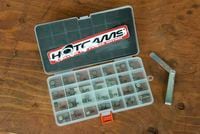WRIST: Ari Henning
MSRP (2015): $5499
MILES: 1,890
MPG: 54
MODS: K&N oil filter, Motorex oil, Hot Cams valve shims
I've been hard on the RC390, and neglectful too. We got the bike with just 63 miles on the odometer and immediately ran it wide open on the dyno and then took it to the track for our 2015 Small Sportbike Shootout and On Two Wheels video. We blew by the initial 620-mile break-in service during testing, and as you can see in the spec box above the bike has nearly 2,000 miles on it now.
That initial service—particularly checking the valve clearances—is important in insuring a bike's performance and longevity. I would never recommend ignoring the first service, and I'm not proud of the fact that I've put it off for this long. Sorry KTM, I was just having too much fun riding the bike to work on it! I did change the oil at about 1,000 miles, however, slipping a K&N filter ($9; knfilters.com) into the crankcase and pouring in the recommended Motorex synthetic oil ($20/liter; motorexusa.com) prior to Editor-in-Chief Marc Cook taking the bike to a track day.
Getting to the valves requires removing the seat, tank cover, side fairings, battery, and fuel tank. I also disconnected the battery lead from the starter solenoid so I could flop the whole fuse box/battery tray off to the left side of the bike. There’s precious little room to work within the RC’s engine compartment so I spent a few minutes zip-tying wires out of the way to give myself a clearer view of the work area. This is all pretty standard stuff—on most bikes the hardest part of the procedure is just getting to the valves.
With the valve cover removed and the engine at top-dead center, I tried to slip my feeler gauge in between the follower and the shim on the intake side, and immediately became frustrated. The cylinder head is tall and the gap you’re attempting to check is an inch down and completely out of site below the cam lobe. I hadn’t wanted to remove the radiator, but I was having a heck of a time accessing the exhaust valves with it in place, so out came the coolant and off came the cooling array. That made things much better. So did having the bike up on a lift; I helped my buddy check the valves on his RC with the bike at ground level and the job was a lot more difficult.
Putting a 45-degree bend in your gauge makes checking the left-side valves fairly easy, but to check the right-side valves you have to slip the gauge through the gap between the cam holder and the head. And on the right exhaust valve you need to make sure you slide the decompression device over so it doesn't interfere with your reading. If you're unfamiliar with how to use feeler gauges or how much drag is the right amount, check out this MC Garage video.
KTM calls for a 0.003-0.005" gap on the intakes and a 0.005-0.007" gap on the exhausts. On my RC the left exhaust was on the snug side of spec (0.005"), and the other three valves were all tighter than spec. (The right exhaust was at 0.004" and the intakes were both at 0.003".)
Since two of my coworkers have personal KTMs that use the same 10mm shims as the RC (and because I may put performance cams in the bike at some point), I went ahead and ordered a full shim kit from Hot Cams ($75.95; hotcamsinc.com) rather than ordering individual pieces from KTM. The RC uses shim kit HCSHIM31 and comes with three shims each in thicknesses from 1.85mm on up to 3.25 mm. The stock shims were all in the 2.40-2.50mm range, so the Hot Cams kit will likely cover any conceivable clearance an RC owner might encounter.
Finding valves out of spec may make your heart sink, but having come this far swapping the shims isn’t that much more work. You need to remove the cam-chain tensioner, spark-plug tunnel (it’s a slip fit with O-rings, wiggle it and it will eventually come free), cam holders, and cams, and then flip the followers up and snatch the shims up with a magnet. I measured all of the shims I took out and replaced them with thinner discs so the clearances are all at the loose end of the spec. I figure since the valves tightened up during that first 2,000 miles, they may continue to do so.
Overall the procedure was a bit more trying than I'd expected, but I think I've been spoiled by the simplicity and ease with which I'm able to check and adjust the clearances on my CBR300R racebike. Compared to the Honda, the KTM is half again more difficult to work on, and anyone looking to tackle the procedure themselves should set aside a full day for the project. And if you're on the fence about checking the valves yourself, consider that I've checked the valves on lots of bikes and found this particular machine pretty tricky to work on. The RC is a great bike for beginners in terms of size, price, and performance, but the same doesn't apply for some of its maintenance procedures.
Thankfully, the next valve-clearance check is 9,300 miles down the road. I’ll make sure to be on time with that one!















/cloudfront-us-east-1.images.arcpublishing.com/octane/7GJYDUIPXRGMTMQKN6ONYOLBOU.jpg)
/cloudfront-us-east-1.images.arcpublishing.com/octane/MUQLOVLL2ZDGFH25ILABNBXKTI.jpg)
/cloudfront-us-east-1.images.arcpublishing.com/octane/TNOU5DNE2BC57MFPMGN2EIDXAM.jpg)
/cloudfront-us-east-1.images.arcpublishing.com/octane/GTCXACQGJ5HAPDTGWUQKDEH44E.jpg)
/cloudfront-us-east-1.images.arcpublishing.com/octane/S35YGSEMEZB4BLTDJTSZPF4GLA.jpg)
/cloudfront-us-east-1.images.arcpublishing.com/octane/5UOT6HPX2JFMRJAX6EH45AR4MQ.jpg)
/cloudfront-us-east-1.images.arcpublishing.com/octane/OKWOJWAKP5EP3OACCRRWPCIX2Q.jpg)
/cloudfront-us-east-1.images.arcpublishing.com/octane/2WF3SCE3NFBQXLDNJM7KMXA45E.jpg)
/cloudfront-us-east-1.images.arcpublishing.com/octane/G4MG6OUCJNBSHIS2MVVOTPX65E.jpg)
/cloudfront-us-east-1.images.arcpublishing.com/octane/IIGGWFOTOJGB7DB6DGBXCCMTDY.jpg)
/cloudfront-us-east-1.images.arcpublishing.com/octane/QSTCM6AVEZA5JJBUXNIQ3DSOF4.jpg)
/cloudfront-us-east-1.images.arcpublishing.com/octane/U4I7G625B5DMLF2DVIJDFZVV6M.jpg)
/cloudfront-us-east-1.images.arcpublishing.com/octane/B6XD6LS6IVCQPIU6HXDJSM3FHY.jpg)
/cloudfront-us-east-1.images.arcpublishing.com/octane/ICL63FEDDRDTTMINYICCEYGMDA.jpg)
/cloudfront-us-east-1.images.arcpublishing.com/octane/FCGZHQXRBZFLBAPC5SDIQLVF4I.jpg)
/cloudfront-us-east-1.images.arcpublishing.com/octane/WNOB6LDOIFFHJKPSVIWDYUGOPM.jpg)

/cloudfront-us-east-1.images.arcpublishing.com/octane/X33NU3E525ECRHXLNUJN2FTRKI.jpg)
/cloudfront-us-east-1.images.arcpublishing.com/octane/6KKT5NNL2JAVBOXMZYS5ZO76YA.jpg)
/cloudfront-us-east-1.images.arcpublishing.com/octane/J5RKG5O455GMPGQRF2OG6LRT7A.jpg)
/cloudfront-us-east-1.images.arcpublishing.com/octane/GX2CIZKQVRH2TATDM26KFG2DAE.jpg)
/cloudfront-us-east-1.images.arcpublishing.com/octane/ZWIDYSAKQZHD5BHREMQILXJCGM.jpg)
/cloudfront-us-east-1.images.arcpublishing.com/octane/CYUHJZCTSJCH3MRAQEIKXK7SCQ.jpg)
/cloudfront-us-east-1.images.arcpublishing.com/octane/LKOFINY56FCXJCANJ5M7ZDQUBY.jpg)